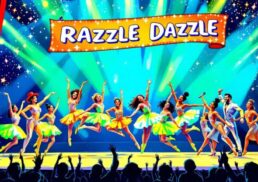Music in the classroom can significantly enhance learning and student engagement. This article explores the cognitive, emotional, and social benefits of using music in daily teaching. Find out how “music in classroom” can create a positive learning environment and discover practical strategies for effective integration.
Table of Contents
Key Takeaways
Integrating music into classroom settings enhances cognitive development, memory retention, emotional well-being, and overall academic performance.
Music supports both emotional expression and social skills, fostering a sense of community and promoting teamwork and empathy among students.
Practical applications of music in education, including using it for transitions, background focus, and lesson hooks, create a positive classroom atmosphere and make learning more engaging and effective.
The Importance of Music in Classroom Settings

Bringing music into the classroom is not just about entertainment; it is a powerful tool that enhances cognitive development, memory retention, and emotional well-being. Studies have shown that music positively impacts students’ learning and overall development by engaging multiple domains, including cognitive, communication, social-emotional, and sensory. This multifaceted approach can lead to better academic performance and a more holistic learning experience.
Music’s ability to elevate spirits and soothe anxieties is especially beneficial in an academic setting. The benefits of incorporating music into education include:
Creating a positive classroom atmosphere, making students more receptive to learning
Fostering fine motor skills
Enhancing language development
Promoting social-emotional growth
These benefits show that extended music education enhances an invaluable component of education, supported by music education research.
Moreover, weaving music into diverse subjects can stimulate deeper comprehension and better student engagement. By connecting abstract concepts with memorable tunes, music helps students retain information and makes learning more enjoyable. We will now explore in detail the cognitive, emotional, and social advantages that music introduces into the classroom.
Cognitive Benefits of Music Education
Music education has been shown to significantly enhance cognitive development in various ways. The benefits include:
Increasing vocabulary
Sharpening memory
Improving articulation and auditory skills
Improved problem-solving skills
Greater memory retention
Better academic performance
Promoting brain plasticity, aiding the brain’s ability to grow and adapt over time.
Moreover, games and activities related to music education make learning theories and note memorization more effective and enjoyable, positively engaging students. Integrating music into the classroom allows teachers to establish a dynamic learning environment that keeps students attentive and motivated. This heightened engagement not only makes lessons more enjoyable but also enhances the way the brain processes information, leading to improved communication skills and overall cognitive development.
Emotional and Social Benefits
Music is a powerful medium for emotional expression, allowing children to convey feelings of happiness, fear, and anger in a healthy and constructive manner. Group music activities, in particular, can foster cooperation and empathy among students, promoting a sense of community within the classroom. Working collaboratively on music projects enables students to learn teamwork and mutual support, thereby enhancing their social abilities.
In addition, classroom music supports comprehensive learning as it positively influences physical, cognitive, social-emotional, and sensory aspects. Some benefits of incorporating music in the classroom include:
Improved memory and cognitive skills
Enhanced creativity and problem-solving abilities
Increased social interaction and teamwork
Boosted emotional well-being and self-expression
Apps like Soundtrap and BandLab enable students to collaborate on music projects in real time, encouraging creative collaboration and teamwork. These activities not only make learning more enjoyable but also help students develop important life skills such as empathy, cooperation, and emotional intelligence.
Practical Ways to Incorporate Music into Daily Classroom Activities
Implementing music into daily classroom activities can transform the learning experience, making it more engaging and effective. Music can facilitate smoother transitions between activities, improve focus, and serve as an engaging lesson hook.
Teachers can apply a variety of strategies to integrate music into their routines, thereby promoting student engagement and enhancing the overall classroom environment. By doing so, they effectively promote student engagement, making learning more enjoyable and interactive for their students.
Using Music for Transitions
Transitions between activities can often be challenging, but music can provide structure and engage students during these times. Familiar songs can serve as cues to signal a change in activity, making it easier for students to shift focus. For example, playing a 30-second song can signal a quick transition, while a longer track can allow more time for students to finish activities. This structured approach helps manage students’ energy levels and ensures smoother transitions throughout the day.
Moreover, songs and chants during transitions provide an enjoyable and captivating method of guiding students through desired actions. By incorporating music into transitions, teachers can increase student movement, induce relaxation, and improve overall classroom organization.
Background Music for Focus
Using background music can effectively establish a calm and focused learning atmosphere. Reflective music played while students write has been shown to help them maintain attention for longer periods, doubling the amount of writing produced. Music helps students concentrate, understand, and remember lessons more effectively, making it an invaluable addition to the classroom.
Music as a Lesson Hook
Employing music as a lesson starter can instantly capture students’ attention and gear them up for learning. Playing themed music at the start of a lesson can set an exciting tone and capture students’ interest. This approach not only makes lessons more engaging but also helps students transition into a learning mindset, ready to absorb new information.
Engaging Students with Music-Based Learning Activities

Activities centered around music can enrich education by:
Deepening student comprehension
Boosting memory retention
Encouraging students to express themselves
Relating to the class material on a personal level
Promoting active engagement and creativity
Creating Educational Songs
Motivating students to craft educational songs stimulates creativity and encourages them to take charge of their learning journey. By rewriting lyrics to popular songs, students can reinforce key concepts and deepen their understanding of the lesson material. This method acts as a powerful mnemonic device, aiding in memory retention and making learning more enjoyable. Some benefits of using educational songs in the classroom include:
Increased engagement and participation
Improved memory retention
Enhanced understanding of complex concepts
Development of creativity and critical thinking skills
Fun and enjoyable learning experience
So why not incorporate educational songs into your teaching repertoire and watch your students thrive?
Instrumental Music for Writing Prompts
Instrumental music can act as an effective backdrop to ignite students’ imaginations during writing tasks. Using instrumental tracks during writing tasks can improve students’ focus and reduce distractions, making the writing process more productive and enjoyable.
Teaching Vocabulary Through Songs
Imparting vocabulary through songs and chants can make learning both fun and easier to remember. Songs with educational content can simplify complex vocabulary, making it more digestible for young learners. This approach not only reinforces learning but also boosts creativity and engagement when played at low volumes during class activities.
Integrating Music Across Different Subjects
Weaving music into multiple subjects can boost student engagement, retention, and comprehension of intricate concepts. By using music as a learning tool, teachers can make lessons more dynamic and memorable, bridging the gap between abstract ideas and practical application.
Music in Math Lessons
Music can assist students in understanding mathematical concepts such as multiplication tables and fractions by using rhythmic patterns. Songs and chants incorporating math concepts can aid in memory retention and reinforce mathematical ideas. Additionally, playing instruments and engaging in music-based games can help students understand patterns, sequences, and functions in math.
Science and Music Integration
Music can efficaciously elucidate scientific concepts, thereby enhancing student engagement and retention. Creating songs about scientific topics, such as the planets or cellular processes, can help students memorize and retain information better. This approach not only makes learning more enjoyable but also enhances understanding of scientific principles through academic research.
History Lessons with Music
Using songs and musical pieces from the time period in history lessons can vivify the subject and offer context. Historical songs can provide an emotional connection to the events being studied, making it easier for students to remember key dates and figures.
Utilizing Technology to Enhance Music Integration
Technology can bolster the integration of music in the classroom by offering teachers a plethora of new tools and resources. Some examples include:
Backing tracks
Digital music notation
Interactive music apps
Online music lessons
Virtual instruments
These tools create a more dynamic and engaging learning environment in modern classrooms, especially for those studying business and social sciences.
Interactive whiteboards and digital audio workstations (DAWs) facilitate thorough music production, recording, editing, and mixing, thus incorporating music into the educational process.
Digital Music Tools
Digital music tools like notation apps and digital audio workstations can enhance music learning and production. Apps such as Solfeg.io and NotateMe provide high-quality recordings, complete notations, and the ability to convert handwritten music into digital format, making it easier for students to learn and share their work.
Online Resources and Platforms
Online resources and platforms offer vast libraries of music and practice tools to support music education. Some examples include:
SoundCloud: Allows students to access and practice songs at home
Smart Music: Provides a wide range of practice tools and accompaniments
AIVA: An AI tool that assists in creating original music pieces, providing inspiration and demonstrating the compositional process
These tools can greatly enhance music education and provide students with valuable resources for learning and practicing music.
Creating a Positive Classroom Atmosphere with Music
Music can foster a positive classroom ambiance by regulating students’ energy levels, encouraging relaxation, and alleviating anxiety. Calming music can reduce aggressive behavior and feelings of stress among students, leading to better performance and a more conducive learning environment.
The act of playing music as students enter the classroom during their school life can establish a relaxed and positive mood for the day, aiding in energy management and fostering a supportive atmosphere, which can increase positive classroom atmosphere. Observing how students perform in such an environment can provide valuable insights for educators.
Morning Music Routines
Establishing morning music routines can create a positive mood for the day and prime students for learning. Classical music in the morning can produce a calming effect by releasing dopamine and inhibiting stress hormones, helping set a positive tone for the day.
Starting the day with a dedicated song can make morning routines engaging and fun for young students.
Music for Brain Breaks
Integrating music into brain breaks can rejuvenate and energize students, thus enhancing the effectiveness of the breaks. Using music as a brain break encourages physical movement, helps children focus better, and can improve students’ overall affect and mood.
Relaxation and Stress Relief
Music therapy can efficiently alleviate anxiety disorders in children, thereby encouraging relaxation and stress relief. By incorporating music therapy into the classroom, teachers can create a more supportive and calming environment, helping students manage stress and improve their well-being.
Learn more, Check out the Effects of music therapy on anxiety: A meta-analysis.
Summary
In summary, integrating music into classroom settings offers numerous cognitive, emotional, and social benefits. By using music to facilitate transitions, enhance focus, and engage students through creative activities, teachers can create a dynamic and positive learning environment. The use of technology further enhances music integration, providing new tools and resources to make music an integral part of education.
Incorporating music into various subjects and daily routines not only makes learning more enjoyable but also promotes a positive classroom atmosphere. By adopting these strategies, teachers can inspire and motivate students, helping them achieve their full potential. Let the power of music transform your classroom and elevate the learning experience for all.
Frequently Asked Questions
How can a teacher use music in the classroom?
A teacher can use music in the classroom to make math memorable, explore historical context through songs, teach poetry through song lyrics, underscore mood or time period, signal classroom transitions, and promote a better classroom culture. Embracing the power of music in these smart ways can enhance the learning experience for students and create a more engaging classroom environment.
How can I use music to help students transition between activities?
You can use familiar songs or short musical cues to signal students to transition smoothly between activities. Different song durations can indicate the time they have to move, ensuring structured and efficient transitions.
What type of music should I use to help students focus?
You should use reflective or instrumental background music to help students focus and maintain attention for longer periods. It creates a calm and focused environment, aiding in concentration.
How can I integrate music into subjects like math and science?
Integrating music can help students understand mathematical concepts like multiplication and fractions, as well as aid in memorization and comprehension of scientific topics such as planets and cellular processes.
What are some digital tools that can enhance music integration in the classroom?
Incorporate digital tools like Solfeg.io, NotateMe, and GarageBand to enhance music integration in your classroom. These tools offer high-quality recordings, notation conversion, and comprehensive environments for music production, enriching the learning experience for students.









